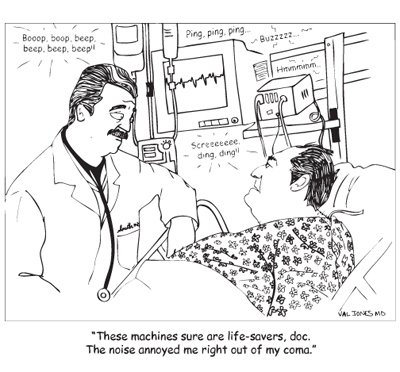April 2nd, 2010 by Medgadget in Better Health Network, News, Research
No Comments »

 Research scientists at MIT have been studying the right temporo-parietal junction (TPJ) region of the brain that seems to be involved in judging the behavior of other people. With the help of transcranial magnetic stimulation (TMS) applied to the region, they were able to affect the moral conclusions that people reached when analyzing the actions of others.
Research scientists at MIT have been studying the right temporo-parietal junction (TPJ) region of the brain that seems to be involved in judging the behavior of other people. With the help of transcranial magnetic stimulation (TMS) applied to the region, they were able to affect the moral conclusions that people reached when analyzing the actions of others.
From MIT news office:
The researchers used a noninvasive technique known as transcranial magnetic stimulation (TMS) to selectively interfere with brain activity in the right TPJ. A magnetic field applied to a small area of the skull creates weak electric currents that impede nearby brain cells’ ability to fire normally, but the effect is only temporary.
In one experiment, volunteers were exposed to TMS for 25 minutes before taking a test in which they read a series of scenarios and made moral judgments of characters’ actions on a scale of one (absolutely forbidden) to seven (absolutely permissible). Read more »
*This blog post was originally published at Medgadget*
April 1st, 2010 by Medgadget in Better Health Network, News, Research
No Comments »

 An Australian company called Simavita is releasing an incontinence detection device to be used in nursing homes across New South Wales. The SIMsystem uses a strip that detects liquid and a cellular device to send a note to a nursing station or a care provider.
An Australian company called Simavita is releasing an incontinence detection device to be used in nursing homes across New South Wales. The SIMsystem uses a strip that detects liquid and a cellular device to send a note to a nursing station or a care provider.
From the product page:
The SIM™box, when fitted into the individual resident’s stretchpants (SIM™pants), transmits sensor readings from the SIM™strip in the SIMpad® over a wireless network to the SIM™server. The SIMsystem™ Manager software running on the SIM™server then detects key information about continence events and determines when to alert care staff about an event requiring attention.
Alerts are sent via text message to the carer’s mobile phone or via the facility’s paging system if preferred. As carers are often unable to immediately respond to events, the software will display a summary log of alerts and manual observations can also be entered. The final bladder chart includes all observations in one easy-to-read report. Read more »
*This blog post was originally published at Medgadget*
March 30th, 2010 by Medgadget in Better Health Network, News, Research
No Comments »

 While gene therapy has always seemed just on the verge of being right around the corner, the limitation has always been delivery of the gene. How do you get the new gene to the right cells and activated?
While gene therapy has always seemed just on the verge of being right around the corner, the limitation has always been delivery of the gene. How do you get the new gene to the right cells and activated?
An in-vivo mice study in the Proceedings of the National Academy of Sciences (PNAS) may take us closer to a usable delivery system. Rui Maeda-Mamiya of the University of Tokyo and others were able to get diabetic mice to increase their insulin levels after delivery of a insulin 2 gene by a water-soluble fullerene. Read more »
*This blog post was originally published at Medgadget*
March 28th, 2010 by Medgadget in Better Health Network, News, Research
No Comments »

 Belgian researchers from the European nanoelectronics and nano-technology research center Imec, Holst Centre, and Katholieke Universiteit in Leuven developed an EEG based writing system that may be helpful for people with severe disabilities.
Belgian researchers from the European nanoelectronics and nano-technology research center Imec, Holst Centre, and Katholieke Universiteit in Leuven developed an EEG based writing system that may be helpful for people with severe disabilities.
The Mind Speller, though, seems very similar to University of Wisconsin-Madison’s communication tool we wrote about a year ago that flashes rows and columns of characters and monitors when the brain notices the character it wants to type.
It detects and interprets P300 event-related potentials in the EEG-signals of a person that is selecting characters from a display presenting alternate rows and columns of characters. P300 potentials are often used as metrics of cognitive function in decision making processes. However, currently available P300 devices are large, expensive and uncomfortable in use. Read more »
*This blog post was originally published at Medgadget*
March 27th, 2010 by Medgadget in Better Health Network, News, Research
No Comments »

 The New York Times profiles research by Harvey A. Liu and Kenneth J. Balkus Jr. of the University of Texas at Dallas to create a therapeutic nitric oxide releasing bandage. Nitric oxide can play a significant role in peripheral vasodilation, relaxation of pulmonary vasculature, and other physiological processes, such as penile erection. Therefore, an effective method of delivering this free radical should allow the development of new types of vascular stockings, bandages, and other therapeutic (or recreational) devices.
The New York Times profiles research by Harvey A. Liu and Kenneth J. Balkus Jr. of the University of Texas at Dallas to create a therapeutic nitric oxide releasing bandage. Nitric oxide can play a significant role in peripheral vasodilation, relaxation of pulmonary vasculature, and other physiological processes, such as penile erection. Therefore, an effective method of delivering this free radical should allow the development of new types of vascular stockings, bandages, and other therapeutic (or recreational) devices.
A snippet from NYT:
As they describe in a paper in Chemistry of Materials, the researchers use a zeolite, an aluminosilicate mineral that has a three-dimensional cage structure. Zeolites have been shown to be able to store and release nitric oxide and other chemicals. They embed the mineral in fibers of a biocompatible polymer, polylactic acid, as they are spun and form a tissue-like mat. The fibers are then infused with nitric oxide; by controlling the porosity of the fibers, the researchers could control the release of the gas.
The researchers say the resulting material could be incorporated into socks for diabetics that would deliver nitric oxide through the skin. It might also prove useful before transplants as a wrapping for organs to help preserve them outside the body for longer.
More from the New York Times…
Abstract in Chemistry of Materials: Novel Delivery System for the Bioregulatory Agent Nitric Oxide
*This blog post was originally published at Medgadget*
 Research scientists at MIT have been studying the right temporo-parietal junction (TPJ) region of the brain that seems to be involved in judging the behavior of other people. With the help of transcranial magnetic stimulation (TMS) applied to the region, they were able to affect the moral conclusions that people reached when analyzing the actions of others.
Research scientists at MIT have been studying the right temporo-parietal junction (TPJ) region of the brain that seems to be involved in judging the behavior of other people. With the help of transcranial magnetic stimulation (TMS) applied to the region, they were able to affect the moral conclusions that people reached when analyzing the actions of others.


 An Australian company called Simavita is releasing an incontinence detection device to be used in nursing homes across New South Wales. The SIMsystem uses a strip that detects liquid and a cellular device to send a note to a nursing station or a care provider.
An Australian company called Simavita is releasing an incontinence detection device to be used in nursing homes across New South Wales. The SIMsystem uses a strip that detects liquid and a cellular device to send a note to a nursing station or a care provider. While gene therapy has always seemed just on the verge of being right around the corner, the limitation has always been delivery of the gene. How do you get the new gene to the right cells and activated?
While gene therapy has always seemed just on the verge of being right around the corner, the limitation has always been delivery of the gene. How do you get the new gene to the right cells and activated? Belgian researchers from the European nanoelectronics and nano-technology research center Imec, Holst Centre, and Katholieke Universiteit in Leuven developed an EEG based writing system that may be helpful for people with severe disabilities.
Belgian researchers from the European nanoelectronics and nano-technology research center Imec, Holst Centre, and Katholieke Universiteit in Leuven developed an EEG based writing system that may be helpful for people with severe disabilities. The New York Times profiles research by Harvey A. Liu and Kenneth J. Balkus Jr. of the University of Texas at Dallas to create a therapeutic nitric oxide releasing bandage. Nitric oxide can play a significant role in peripheral vasodilation, relaxation of pulmonary vasculature, and other physiological processes, such as penile erection. Therefore, an effective method of delivering this free radical should allow the development of new types of vascular stockings, bandages, and other therapeutic (or recreational) devices.
The New York Times profiles research by Harvey A. Liu and Kenneth J. Balkus Jr. of the University of Texas at Dallas to create a therapeutic nitric oxide releasing bandage. Nitric oxide can play a significant role in peripheral vasodilation, relaxation of pulmonary vasculature, and other physiological processes, such as penile erection. Therefore, an effective method of delivering this free radical should allow the development of new types of vascular stockings, bandages, and other therapeutic (or recreational) devices.







